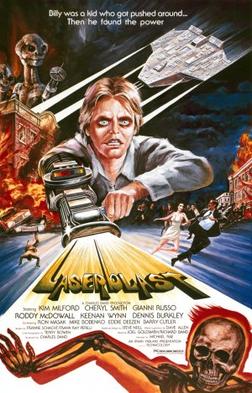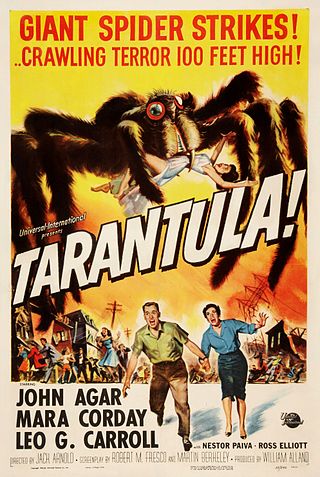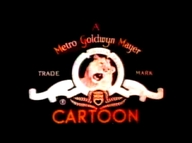
The Goonies is a 1985 American adventure comedy film directed and co-produced by Richard Donner from a screenplay by Chris Columbus based on a story by Steven Spielberg and starring Sean Astin, Josh Brolin, Jeff Cohen, Corey Feldman, Kerri Green, Martha Plimpton, and Ke Huy Quan, with supporting roles done by John Matuszak, Anne Ramsey, Robert Davi, Joe Pantoliano and Mary Ellen Trainor. In the film, a group of kids who live in the "Goon Docks" neighborhood of Astoria, Oregon, attempt to save their homes from foreclosure and, in doing so, they discover an old treasure map that takes them on an adventure to unearth the long-lost fortune of One-Eyed Willy, a legendary 17th-century pirate. During the adventure, they are pursued by a family of criminals who want the treasure for themselves.

Roderick Andrew Anthony Jude McDowall was a British-American actor, whose career spanned over 270 screen and stage roles across over 60 years. Born in London, he began his acting career as a child in his native England, before moving to the United States at the outbreak of World War II. He achieved prominence for his starring roles in How Green Was My Valley (1941), My Friend Flicka (1943), and Lassie Come Home (1943). Unlike many of his contemporaries, McDowall managed to transition his child stardom into adulthood, and began to appear on Broadway as well as in films, winning a Tony Award for his performance in Jean Anouilh's The Fighting Cock. For portraying Octavian in the historical epic Cleopatra (1963), he was nominated for a Golden Globe Award.

Warner Bros. Television Studios is an American television production and distribution studio of the Warner Bros. Television Group division of Warner Bros.. Since 2006, it is one of the two companies that serve as television production arms of The CW, alongside Paramount Global's subsidiary CBS Studios; it serves as a television production arm of DC Comics productions by DC studios and distribution arm of HBO, Cartoon Network and Adult Swim. Warner Bros. Television Studios has also produced shows for other networks such as Blindspot and Found on NBC, Person of Interest on CBS, The Cleaning Lady on Fox and Abbott Elementary on ABC. It has also produced series for streaming services, including The Sandman on Netflix, Ted Lasso on Apple TV+, The Peripheral on Amazon Prime Video and Mrs. Davis on Peacock.
Warner Bros. Cartoons, Inc. was an American animation studio, serving as the in-house animation division of Warner Bros. during the Golden Age of American animation. One of the most successful animation studios in American media history, it was primarily responsible for the Looney Tunes and Merrie Melodies series of animated short films. The characters featured in these cartoons, including Bugs Bunny, Daffy Duck, and Porky Pig, are among the most famous and recognizable characters in the world. Many of the creative staff members at the studio, including directors and animators such as Chuck Jones, Friz Freleng, Robert McKimson, Tex Avery, Robert Clampett, Arthur Davis, and Frank Tashlin, are considered major figures in the art and history of traditional animation.

The Legend of Hell House is a 1973 gothic supernatural horror film directed by John Hough, and starring Pamela Franklin, Roddy McDowall, Clive Revill, and Gayle Hunnicutt. It follows a group of researchers who spend a week in the former home of a sadist and murderer, where previous paranormal investigators were inexplicably killed. Its screenplay was written by American author Richard Matheson, based upon his 1971 novel Hell House.

Merlin the Magic Mouse is an animated cartoon mouse, who starred in five Warner Bros. Looney Tunes shorts late in the series, from 1967 to 1969. The first cartoon was Merlin the Magic Mouse, directed by Alex Lovy.

Seven Arts Productions was a production company which made films for release by other studios. It was founded in 1957 by Eliot Hyman, Ray Stark, and Norman Katz.

Laserblast is a 1978 American independent science fiction film directed by Michael Rae and produced by Charles Band, widely known for producing B movies. Starring Kim Milford, Cheryl Smith and Gianni Russo, featuring Keenan Wynn and Roddy McDowall, and marking the screen debut of Eddie Deezen, the plot follows an unhappy teenage loner who discovers an alien laser cannon and goes on a murderous rampage, seeking revenge against those who he feels have wronged him.

It's Alive is a 1974 American science fiction horror film written, produced, and directed by Larry Cohen. It stars John P. Ryan and Sharon Farrell as a couple whose infant child turns out to be a vicious mutant. The film's cast also includes James Dixon, William Wellman Jr., Shamus Locke, Andrew Duggan, Guy Stockwell, and Michael Ansara. The baby was designed and created by special effects make-up artist Rick Baker, and the film's score was composed by Bernard Herrmann.
This is a complete list of the 166 shorts in the Tom and Jerry series produced and released between 1940 and 2021. Of these, 162 are theatrical shorts, one is a made-for-TV short, one is a two-minute sketch shown as part of a telethon, and two are special shorts released on HBO Max.

Tarantula is a 1955 American science-fiction monster film produced by William Alland and directed by Jack Arnold. It stars John Agar, Mara Corday, and Leo G. Carroll. The film is about a scientist developing a miracle nutrient to feed a rapidly growing human population. In its unperfected state, the nutrient causes extraordinarily rapid growth, creating a deadly problem when a tarantula test subject escapes and continues to grow larger and larger. The screenplay by Robert M. Fresco and Martin Berkeley was based on a story by Arnold, which was in turn inspired by Fresco's teleplay for the 1955 Science Fiction Theatre episode "No Food for Thought", also directed by Arnold. The film was distributed by Universal Pictures as a Universal-International release, and reissued in 1962 through Sherman S. Krellberg's Ultra Pictures.

MGM Animation/Visual Arts was an American animation studio established in 1962 by animation director/producer Chuck Jones, producer Les Goldman and executive Walter Bien as Sib Tower 12 Productions. Its productions include the last series of Tom and Jerry theatrical shorts, the TV specials Horton Hears a Who! and How the Grinch Stole Christmas!, and the feature film The Phantom Tollbooth, all released by Metro-Goldwyn-Mayer.

Arthur P. Jacobs was a film producer. Prior to being a producer, he worked in various studios and was a press agent. Beginning in 1963 until his death, he was responsible for film productions such as the Planet of the Apes series, Doctor Dolittle, Goodbye, Mr. Chips, Play It Again, Sam and Tom Sawyer through his company APJAC Productions.

Madhouse is a 1974 horror film directed by Jim Clark for Amicus Productions in association with American International Pictures. The film, which is a British-American co-production, stars Vincent Price, Natasha Pyne, Peter Cushing, Robert Quarry, Adrienne Corri, and Linda Hayden. The film was based on the 1969 novel Devilday by Angus Hall. The film's alternate title is The Revenge of Dr. Death.

The Metro-Goldwyn-Mayer cartoon studio was an American animation studio operated by Metro-Goldwyn-Mayer (MGM) during the Golden Age of American animation. Active from 1937 until 1957, the studio was responsible for producing animated shorts to accompany MGM feature films in Loew's Theaters, which included popular cartoon characters Tom, Jerry, Droopy, Butch, Spike, Tyke, and Barney Bear.

Desperate Journey is a 1942 American World War II action and aviation film directed by Raoul Walsh and starring Errol Flynn and Ronald Reagan. The supporting cast includes Raymond Massey, Alan Hale Sr., and Arthur Kennedy. The melodramatic film featured a group of downed Allied airmen making their way out of the Third Reich, often with their fists.

Bedlam is a 1946 American horror film directed by Mark Robson and starring Boris Karloff, Anna Lee and Richard Fraser, and was the last in a series of stylish horror B films produced by Val Lewton for RKO Radio Pictures. The film was inspired by William Hogarth's 1732–1734 painting series A Rake's Progress, and Hogarth was given a writing credit.
Satellite in the Sky is a 1956 British CinemaScope science fiction film in Warner Color, produced by Edward J. Danziger and Harry Lee Danziger, directed by Paul Dickson, and starring Kieron Moore, Lois Maxwell, Donald Wolfit, and Bryan Forbes. It was distributed by Warner Bros. Pictures. Special effects were by Wally Veevers, who would later work on Stanley Kubrick's 2001: A Space Odyssey (1968).

Earthbound is a 1940 film directed by Irving Pichel. It stars Warner Baxter and Andrea Leeds. It is a remake of the 1920 silent film of the same name, Earthbound. Critical reception to the film was generally negative.

Jerry Beck is an American animation historian, author, blogger, and video producer.

















